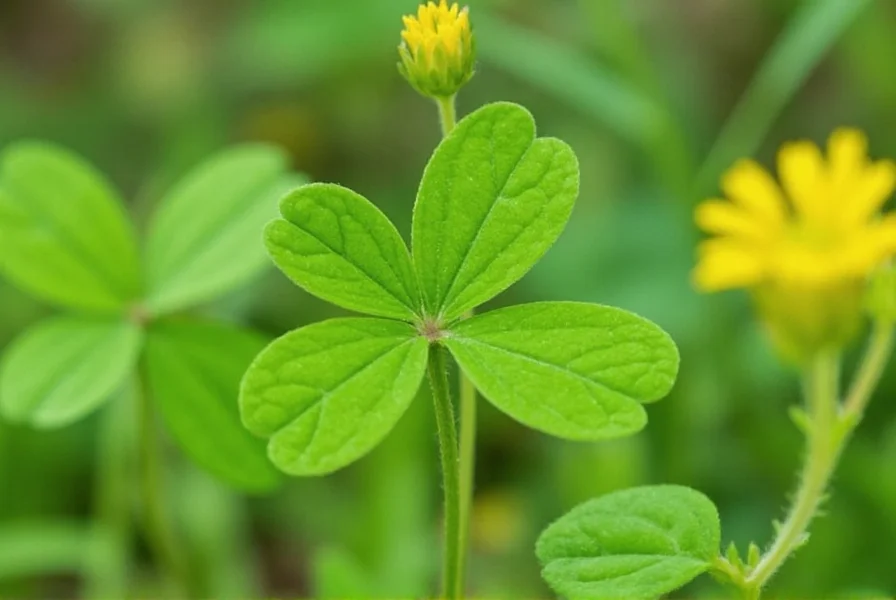Arrowleaf clover stands out among legume species for its adaptability and agricultural benefits. This annual plant, scientifically classified as Trifolium vesiculosum, features distinctive arrowhead-shaped leaflets that give it its common name. Unlike perennial clovers, arrowleaf completes its life cycle within one growing season, making it particularly valuable for rotational planting systems.
Botanical Characteristics and Identification
Identifying arrowleaf clover involves recognizing several key features. The plant typically reaches 12-24 inches in height with hollow, branched stems. Its most distinctive characteristic is the leaf shape—each trifoliate leaf has one large terminal leaflet and two smaller lateral leaflets, all with a pronounced arrowhead shape and a light V-shaped watermark.
During its flowering period (typically April-June in temperate regions), arrowleaf produces white to pale pink flower heads containing 20-40 individual flowers. These develop into seed pods that contain 2-4 seeds each. The plant's deep taproot system, which can reach depths of 3-4 feet, contributes to its drought tolerance and soil improvement capabilities.
| Feature | Arrowleaf Clover | White Clover | Crimson Clover |
|---|---|---|---|
| Life Cycle | Annual | Perennial | Annual |
| Leaf Shape | Arrowhead-shaped | Rounded | Oblong |
| Flower Color | White to pale pink | White | Bright red |
| Root System | Deep taproot | Shallow fibrous | Moderate taproot |
| Drought Tolerance | High | Low | Moderate |
Habitat and Geographic Distribution
Native to the Mediterranean basin, arrowleaf clover has adapted well to similar climates worldwide. It performs best in regions with mild winters and moderate rainfall (20-40 inches annually). Unlike many clover species, arrowleaf demonstrates remarkable tolerance for poorly drained soils and can thrive in areas with seasonal waterlogging.
In the United States, it's particularly well-suited to the southeastern states, Pacific Northwest, and California. The plant prefers slightly acidic to neutral soils (pH 5.5-7.0) but shows better tolerance for lower pH conditions than many other clovers. Its ability to grow in moist areas makes it valuable for riparian buffers and flood-prone fields where other legumes struggle.
Agricultural Benefits and Forage Value
Arrowleaf clover offers substantial benefits for sustainable farming systems. As a nitrogen-fixing legume, it typically adds 100-150 pounds of nitrogen per acre to the soil, reducing fertilizer requirements for subsequent crops. This natural soil enrichment makes it an excellent component of crop rotation plans, particularly following cereal grains.
For livestock producers, arrowleaf clover provides high-quality forage with crude protein levels ranging from 18-25% when grazed at the proper stage. Its palatability exceeds that of many other annual clovers, leading to excellent animal performance. Unlike some clovers, it carries minimal risk of bloat when managed properly, making it safer for continuous grazing systems.

Cultivation Requirements and Management
Successful establishment of arrowleaf clover requires attention to several key factors. Planting typically occurs in early fall (September-October in temperate zones) at a rate of 8-10 pounds per acre when drilled, or 12-15 pounds when broadcast. Seed should be placed no deeper than 1/4 inch in well-prepared seedbeds.
Inoculation with the appropriate Rhizobium strain (specific to arrowleaf clover) is essential for optimal nitrogen fixation. While the plant tolerates moderate acidity, liming to achieve pH 6.0-6.5 significantly improves establishment and persistence. Unlike some legumes, arrowleaf clover generally requires minimal phosphorus and potassium beyond what's needed for the companion grasses.
One of arrowleaf clover's most valuable traits is its self-seeding capability. When allowed to mature and set seed, it reliably reestablishes in subsequent years, reducing the need for annual reseeding. This characteristic makes it particularly valuable for low-input pasture systems and wildlife food plots.
Ecological Advantages and Biodiversity Support
Beyond agricultural applications, arrowleaf clover contributes significantly to ecosystem health. Its extended flowering period provides nectar resources for bees and other pollinators when many other plants have finished blooming. Research shows that fields containing arrowleaf clover support 30-50% more pollinator species than conventional pasture mixes.
The plant's deep root system improves soil structure by creating channels that enhance water infiltration and aeration. This characteristic makes arrowleaf clover particularly valuable for soil remediation in compacted fields. Additionally, its ability to grow in moist conditions makes it effective for erosion control along stream banks and in low-lying areas prone to periodic flooding.

Comparison with Other Clover Species
When selecting clovers for pasture improvement, understanding the differences between species is crucial. Arrowleaf clover occupies a unique niche between white clover (a low-growing perennial) and crimson clover (a faster-maturing annual).
Unlike white clover, which spreads by stolons and forms dense mats, arrowleaf grows more upright and tolerates taller grass competition better. Compared to crimson clover, arrowleaf has superior drought tolerance and a longer grazing season, though it establishes slightly slower. Its seed production exceeds that of many other annual clovers, enhancing its reseeding potential.
For farmers considering arrowleaf clover for pasture improvement, the decision often comes down to specific site conditions. In areas with heavy spring rains or poorly drained soils, arrowleaf typically outperforms other clovers. In drier regions with well-drained soils, berseem or crimson clover might be better choices.
Practical Applications for Modern Farming
Today's sustainable farming operations increasingly recognize the value of growing arrowleaf clover as part of integrated systems. Organic producers appreciate its nitrogen-fixing capabilities, while conventional operations use it to reduce synthetic fertilizer inputs. Its compatibility with cool-season grasses like orchardgrass and tall fescue makes it ideal for mixed pasture systems.
For those developing a arrowleaf clover planting guide, timing is critical. In Mediterranean climates, planting should coincide with the first autumn rains. In more temperate regions, late summer to early fall planting allows for optimal root development before winter. When overseeding existing pastures, light tillage or frost seeding can improve establishment success.
The growing interest in regenerative agriculture has renewed attention on arrowleaf clover soil benefits. Its deep roots break up compaction, while its residue contributes organic matter as it decomposes. When used in cover crop mixes, it provides both nitrogen and biomass, supporting soil microbial communities throughout the growing season.
Conclusion
Arrowleaf clover represents a valuable tool for sustainable agriculture, offering benefits that extend beyond simple forage production. Its unique combination of soil improvement capabilities, drought tolerance, and high-quality nutrition makes it particularly valuable in diverse farming systems. Whether used as a cover crop, in pasture mixes, or for soil remediation, this adaptable legume continues to prove its worth in modern agricultural practices focused on sustainability and ecosystem health. As interest in regenerative agriculture grows, arrowleaf clover characteristics position it as an increasingly important component of resilient farming systems worldwide.











 浙公网安备
33010002000092号
浙公网安备
33010002000092号 浙B2-20120091-4
浙B2-20120091-4